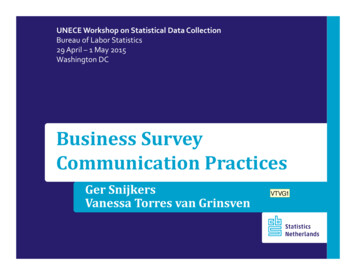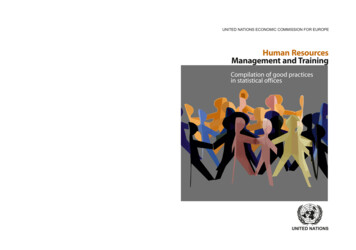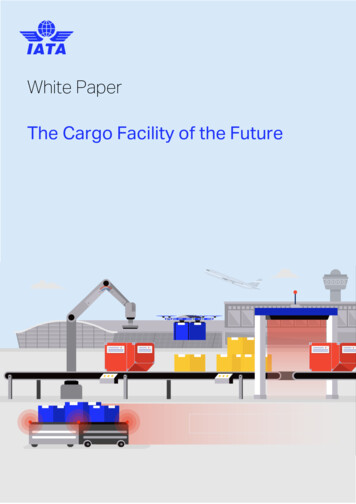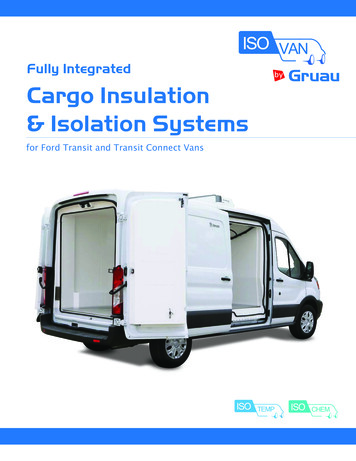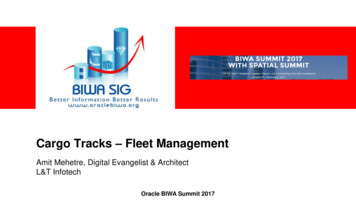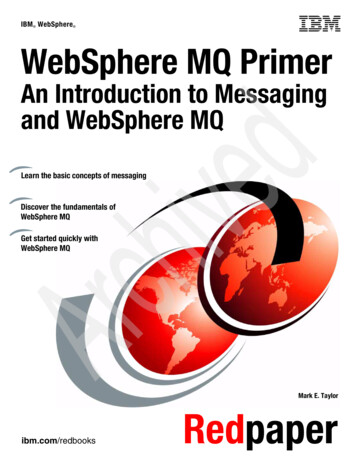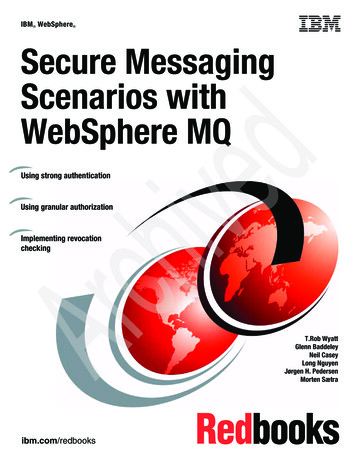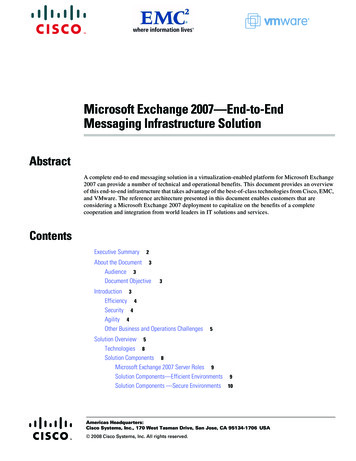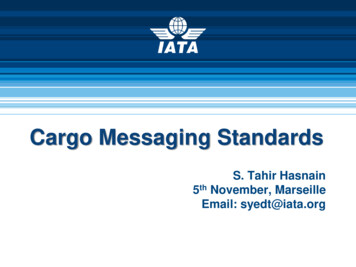
Transcription
Cargo Messaging StandardsS. Tahir Hasnain5th November, MarseilleEmail: syedt@iata.org
Role of Electronic Messaging in Air Cargo Facilitate Air Cargo end to end business processes including Sales,Operations and Finance. Fulfill Customs Requirements for Advance Cargo Information (ACI) e.g.US-AMS, EU-ICS, CA-ACI etc.Note: The Messaging standards are also used in US-ACAS pilots Compliance with Security Regulations such as electronic ConsignmentSecurity (e-CSD) etc.2
Air Cargo Messaging Standards Two messaging standards are available in the air cargo industry Cargo-IMP (traditional) Cargo-XML (emerging)Developed and Maintained by the specific industry groups Cargo-Data Interchange Task Force (CDITF) Cargo-XML Task Force (CXMLTF)Distributed by IATA through the specific publications Cargo-IMP Manual Cargo-XML Manual and Toolkit3
Cargo-IMP Standards Exist since 1975 - initially used by airlines for cargo interlining Initially exchanged using traditional SITA Type B Messaging Expanded to big forwarders, GHAs and some Customs Admin Hundreds of million of CIMP messages exchanged per year Cargo-IMP Manual 34th edition was produced in 2014 78 Cargo-IMP Messages are available in the latest edition4
Cargo-XML Standards Development started in 2010 Support modern technology and are exchanged over the internet Based on the UN/CEFACT standards and compatible with WCO DM Multimodal and Cross-border Limited adoption by the industry Cargo-XML Manual 3rd edition was produced in 2015 15 Cargo-XML Messages are available in the latest edition5
Industry Cargo-EDI Strategy IATA has stopped producing new editions of Cargo-IMP Manual. Cargo-IMP Manual 34th is the last & final edition. Further developments in the Cargo-XML Messages only. Cargo-XML Manual and Toolkit is maintained.Note: Cargo-IMP Messages can still be used but there will be no new versions.6
IATA Recommendation“Use latest versions of Cargo-IMPoradopt Cargo-XML Standards”7
Cargo-XMLTask Force(CXMLTF)8
Cargo-XML Task Force (CXMLTF)DACHSER9
CXMLTF – Approach to recommend new standardsUNECEISOUnited Nations Economic Commission forEuropeInternational Organisation forStandardisation / Technical CommitteeCCTSUN/CEFACT CoreComponent TechnicalSpecificationCross BorderSupply Chain DataModelUNTDEDUnited Nation Trade Data Element DirectoryUN/CEFACT CCLUN/CEFACT Core Component LibraryUN Layout Key(Recommendation n 1)Task Force &Vendors InputWCO Revised Kyoto Convention &WCO Data ModelIATA Cargo-XML MessagesCooperation withStandardization bodiesTBG1, 2, 3, 4, 17UNECEUN/EDIFACTUN/CEFACTUN/CEFACTNDRsXML Naming and DesignRulesList of Trade FacilitationRecommendations10
Cargo-XML Messages(1/2) CXMLTF has developed 15 Cargo-XML Messages that has beenendorsed by the IATA Cargo Services Conference (CSC). These are:Transport MessagesAcronymCommercial MessagesAcronymXML WaybillXFWBXML InvoiceXINVXML House WaybillXFZBXML Packing ListXPCLXML House ManifestXFHLXML Certificate of OriginXCOOXML Flight ManifestXFFMXML Shippers Letter of InstructionXSLIXML Freight Booked ListXFBLXML Status MessageXFSUXML Response MessageXFNMXML Booking MessageXFFRXML Custom Status NotificationXCSNXML Shippers Dec for DGXSDGXML Generic Request MessageXGRQ11
Cargo-XML Messages(2/2) XML Rate Information Message is beingdeveloped. Intended to be used for rates exchange betweenairlines and partners. Rates such as Market/Contract/Spot12
Cargo-IMP vs Cargo-XMLFeaturesCharacter SetSizeField/LineMessageScopeOccurrencesMessage StructureData TypeCommunication MediumPlatform DependentData QualityError HandlingData ValidationUN/CEFACT StandardsMultimodalCross-borderCargo-IMPLimited (ASCII 7 bit)Limited65 characters3500 charactersAirport to AirportLimitedConstraintsLimitedTraditionally Proprietary (Now Public)YesModestCumbersomeNoNo CompatibilityNoNo13Cargo-XMLExtended (UTF -8)ExtendedunlimitedunlimitedEnd to end supply chainUnlimitedFlexibleExtendedPublic - Internet basedNoImprovedImprovedYes (XSD)CompatibleYesYes
Cargo-XML – DimensionsPublicationCargo-XML standards are delivered inan innovative way that:ACIAdvocacy(Customs &Security) Improves industry efficiency Facilitates industry adoption Allows compliance with Regulations Facilitates pTraining /ConsultancyEvents /Workshops14
Where are the Cargo-XMLmessages published?(Cargo-XML Manual and Toolkit)PublicationACIAdvocacy(Customs& cargoxml-toolkit15
Cargo-XML Manual and Toolkit 3rd Edition Published Annually 3rd Edition is latest effective1st January 2015 Regular web updates16
Features of 3rd EditionCargo-XMLStandardsProminent Features: Messages -Specs & schemas Cargo-XML ScorecardMigration Guidelines betweenFAQ, Code ListFreightForwardersBusiness Rules Data Elements Specs & SchemaLinkageCargo-IMP Cargo-XML Cargo-XML ImplementationStrategies – a White PaperDownload SectionLayout & Examples Conversion Guidelines Message Layouts Sample Messages White PaperIT Service ProvidersMappings withCargo-IMP Manual17 Cargo-IMP, WCO UNTDED
Cargo-XML Scorecard for CXMLTF18
Cargo-XML White Paper19
What are the Tools available forCargo-XML Adoption?PublicationACIAdvocacy(Customs& -xml-autocheck.iata.org/20
Cargo-XML Autocheck Powerful online service Syntax check validation Self-test without partner Support during rollout andwhen connecting additionalpartners Permanent availability (24/7) High data quality and integrity Test results immediatelyavailable Fast overview of the /21
Cargo-XML & ata.org/training/22
Why Cargo-XML Training?23
Cargo-XML Training Cargo-XML Training Course is available Classroom Training at IATA trainingcenter and in-company In company Training - tailored as peryour requirements Miami training took place Feb 2nd, 13people UK training took place on Jun 4th, 7people Airlines, ground handlers and ITProviders) Project managers and developersClick here to visit webpage for Cargo-XML Training24
Cargo-XML Standards WorkshopsPublicationACIAdvocacy(Customs& /events/cargo-xml-workshop25
Cargo-XML WorkshopsHighlights Industry experts share implementationexperience Discussions on strategies to adopt Cargo-XML Migration from Cargo-IMP to Cargo-XML Tools and resources available for implementation26
Strategic Partner/IT ServiceProviders and Cargo-XMLPublicationAEIAdvocacy(Customs& /cargoxml-toolkit27
IT Providers (Strategic Partners) & Cargo-XMLLicenses (1/2)28
IT Providers (Non Strategic Partners) & Cargo-XMLLicenses (2/2)29
Customs and Cargo-XML StandardsPublicationACIAdvocacy(Customs& /cargoxml-toolkit30
Customs & IATA Cargo-XML StandardsFollowing Customs Authorities have got IATA Cargo-XML Manual and Toolkit: World Customs Organization (WCO) CA-CBSA US-CBP Mexican Customs Argentinian Customs Paraguay Customs Pakistan Customs Abu Dhabi Customs Qatar Customs Bahrain Customs31
IATA & UNCTADsigned MoU on adoption of Cargo-XMLstandards in ASYCUDA World32
C-IMP to Cargo-XML MigrationA Challenge?Tahir SyedManager Cargo Technology, IATASyedt@iata.orgThursday, Nov 5th 201533
Transition to the Cargo-XML How do I support my partnerswho continue to use Cargo-IMP?34
Transition to the Cargo-XML To what extent Cargo-XML andC-IMP are compatible?35
Transition to the Cargo-XML What is the impact of big sizeCargo-XML message onbandwidth of my network?36
Key FundamentalsCargo-XML adoption is highly dependent on your:1. Business partners2. Cargo Management System Setup3. Messaging Framework4. Communication Methodology37
Implementation Strategies Generally, there are two types of Cargo-XML implementations:1. Direct Cargo-XML adoption Both Sender and Recipient exchange Cargo-XML messages2. Transformation between Cargo-IMP and Cargo-XML Either Sender or Recipient is converting from one format to another. Applicable when migrating from Cargo-IMP to Cargo-XML supporting partner that uses a different standard38
Message Exchange ModelsModel 1 – Communication with Cargo-IMP PartnerCargo-XMLConversion to C-IMPTransmit C-IMPCargo-IMPConversion to C-IMPTransmit C-IMPModel 2 – Communication with Cargo-XML PartnerCargo-XMLConversion to C-IMPTransmit Cargo-XMLCargo-IMPConversion to C-XMLTransmit Cargo-XML39
Transition Facilitation IATA is facilitating industry transition to Cargo-XML by offering: “Migration Guidelines” between C-IMP and Cargo-XML “Data Length Recommendations” for Cargo-XML “Mapping” between C-IMP and Cargo-XML “White Paper” communicating implementation strategies “Message Samples” for C-IMP and equivalent Cargo-XML “Support Desk” for Cargo-XMLNote: All of above is published in the IATA Cargo-XML Manual and Toolkit and also available on the www.iata.org/cargo-xml40
Basic Components for Conversion1. Character Set2. Field Length3. Field Occurrence4. Structure5. Semantic6. Field Existence7. Data Types8. Message Split41
C-IMP to Cargo-XML Conversion42
Cargo-XML to C-IMP Conversion43
For further details visit http://www.iata.org/cargo-xml44
IATA has stopped producing new editions of Cargo-IMP Manual. Cargo-IMP Manual 34th is the last & final edition. Further developments in the Cargo-XML Messages only. Cargo-XML Manual and Toolkit is maintained. Note: Cargo-IMP Messag

